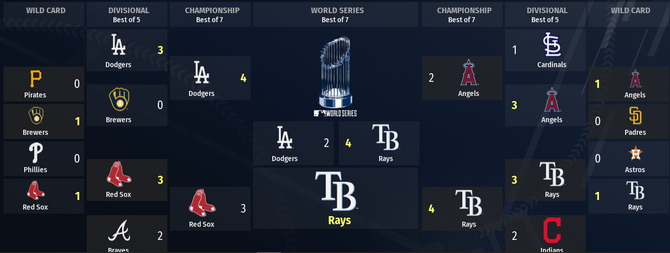One thing is for certain about Major League Baseball's 2020 season: whatever form it takes (if any at all) will look considerably different than the standard, pre-coronavirus variety. That likely means the season will see fewer games, with those games being played in empty ballparks that wouldn't necessarily house the home team in question.
We reported last week on one proposal in MLB circles that would see teams split between three "hubs," located in Phoenix, Arizona; Arlington, Texas; and St. Petersburg, Florida. Should that scenario come to pass, the league could assign 10 teams per hub, splitting up the divisions so that all the East, Central, and West teams are located in one area. USA Today's Bob Nightengale recently laid out a similar alignment, with one tweak: the Atlanta Braves being placed in the "Central" hub, while the Pittsburgh Pirates were in the "East" hub.
Here's that same information in a digestible graphic:
Because we are nothing if not curious, we decided to fire up our copy of Outside the Park Baseball 21 and simulate a season using those alignments. (You might recall that we did something similar back when the proposal de jour involved just two sites.) Before we get to the results, let's hit on some of the logistical tweaks we made heading into the season:
Every team played 100 regular-season games, with the campaign beginning in July.
The top four teams in each of the three divisions qualified for the postseason, meaning 12 teams in total.
The four best teams by winning percentage each received a first-round bye.
The bottom eight playoff teams, meanwhile, were entered into four one-game playoffs -- four Wild Card Games, if you will.
The rest of the playoffs format -- best-of-five, then consecutive best-of-seven series -- remained the same, albeit without the National and American League aspects.
Got it? Good. Let's move on to the results, beginning with a division-by-division look.
The East

One theme you'll notice here is the prevalence of ties. In the East alone, you have three teams tied for that final playoff spot: the Philadelphia Phillies, the New York Yankees, and the Washington Nationals. The Phillies ended up claiming that spot, for the record.
The most surprising developments in the East were the Boston Red Sox winning the division (albeit with the fifth-best record in the sport), and the Pittsburgh Pirates -- yes, the Pittsburgh Pirates -- willing their way into a playoff spot. Good job, virtual Derek Shelton. Those teams were joined in the postseason by the Tampa Bay Rays. Keep that in mind for later.
The Central

Over in the Central, the biggest shocker is the poor performance of the Chicago Cubs. Who had them finishing within three games of both the Detroit Tigers and the Kansas City Royals? Ouch. The Minnesota Twins, who entered the year as the favorites in the real-world American League Central, finishing under. 500 also qualifies as a surprise.
The four playoff teams from the Central were otherwise who you would expect: Cleveland, the St. Louis Cardinals, Atlanta Braves, and Milwaukee Brewers. The Chicago White Sox and Cincinnati Reds, two of the offseason's most aggressive clubs, each finished at least a handful of games beyond a playoff spot.
The West

We noted there were going to be some more ties in this simulation. Here you have it, with the Houston Astros, San Francisco Giants, and Los Angeles Angels finishing deadlocked for the final two postseason spots in the division. The Angels and Astros ended up claiming them.
Those clubs were joined in the postseason by the Los Angeles Dodgers (of course) and the San Diego Padres, who were big winners in our last simulation.
Now, onto the playoffs.
The postseason

In lieu of the usual League Championship setup, we'll just note that the final four included the Dodgers, Red Sox, Angels, and Rays. The Dodgers and Rays prevailed, and went on to play a six-game World Series -- the Andrew Friedman Bowl, if you will. The Rays ended up winning out, notching the first championship in the franchise's history.
Miscellany
That's all for team-level performances. What about individuals? Let's get to it.
Mike Trout was, surprise surprise, the best player in the game, according to the Wins Above Replacement metric. Trout was worth 5.8 WAR, a tick more than Juan Soto (5.7) and Ozzie Albies (5.6), who led the league in average (.343).
Bryce Harper (34) edged Mike Moustakas (33), Joey Gallo, and Luis Robert (31) for the homer title.
The Cardinals staff featured the No. 1 and 2 finishers in ERA (Carlos Martinez and Jack Flaherty) and the saves leader (Giovanny Gallegos). Flaherty also led the league in wins, with 13. Is it any wonder how they made the postseason?
Gerrit Cole led the majors in WAR, with 6.5. That's two more wins than anyone else had on the pitching side, and 0.7 wins more than Trout.
The most surprising individual stat we could find? Chris Bassitt finishing with a league-best two shutouts … despite having an ERA over 5.00 for the season. Perhaps this is a case where when he was good, he was really good, and when he wasn't good, he … well, you get it.
Join us again next week, when we use OOTP to find out what happens when half the league is stationed on the moon.
Bagikan Berita Ini














0 Response to "10-team MLB divisions? Here's how 2020 season played out in simulation of potential realignment - CBS Sports"
Post a Comment